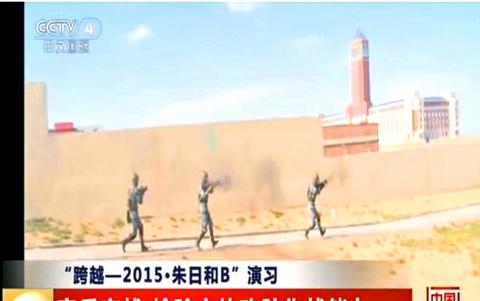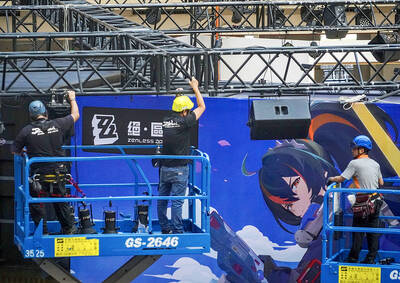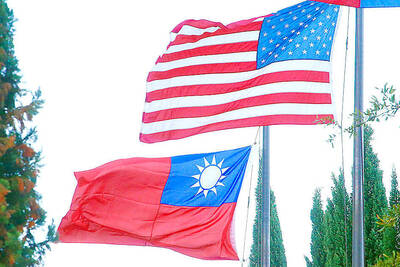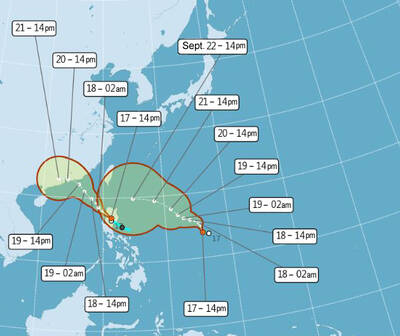The appearance of structures similar to the Presidential Office Building in China’s recent war games sparked Internet debate over whether the footage was a targeted provocation against Taiwan and a demonstration of China’s willingness to resort to military force to unify Taiwan with China.
In the most recent Military Report show aired by Chinese state-media China Central Television (CCTV) on July 5, exercises at the Zhurihe Training Base in the Inner Mongolia Autonomous Region successfully simulated a “decapitation” strategy and demonstrated high efficiency in intelligence gathering where unmanned aerial vehicles (UAV), helicopters and recon teams sent back hundreds of photographs to command.
The three-minute video clip featured special forces personnel sprinting into a five-story building with a tower in one of the Stride 2015 Zhurihe series of exercises by the People’s Liberation Army (PLA).

Photo: CNA screen grab from CCTV
The footage showing Chinese troops maneuvering toward a building resembling the Presidential Office Building was not the first time Chinese forces have simulated an attack on Taiwan in military exercises.
The PLA reportedly built a replica of Taichung’s shared-use Cingcyuangang Air Field in China’s Gansu Province to simulate attacks on the airfield. The PLA Army, PLA Air Force and special forces also reportedly established a special forces team in the Nanjing military zone that was fluent in Hoklo (commonly known as Taiwanese) earlier this year.
Ministry of National Defense spokesman Major General David Lo (羅紹和) yesterday said that the implied target of the military exercise was detrimental to cross-strait relations and was not an action either the Taiwanese or the international community could accept.
The ministry is up to date on all PLA exercises and while adhering to President Ma Ying-jeou’s (馬英九) instructions of “three defensive lines” and not embarking on an arms race with China, the military maintains a force that would effectively deter Taiwan’s enemies and capably defend the nation, Lo said.
The three defensive lines refers to Ma’s previous statements, with the first being institutionalized relations with China; the other two the country’s soft power and international support for Taiwan.
Additional reporting by CNA

Taiwan is projected to lose a working-age population of about 6.67 million people in two waves of retirement in the coming years, as the nation confronts accelerating demographic decline and a shortage of younger workers to take their place, the Ministry of the Interior said. Taiwan experienced its largest baby boom between 1958 and 1966, when the population grew by 3.78 million, followed by a second surge of 2.89 million between 1976 and 1982, ministry data showed. In 2023, the first of those baby boom generations — those born in the late 1950s and early 1960s — began to enter retirement, triggering

ECONOMIC BOOST: Should the more than 23 million people eligible for the NT$10,000 handouts spend them the same way as in 2023, GDP could rise 0.5 percent, an official said Universal cash handouts of NT$10,000 (US$330) are to be disbursed late next month at the earliest — including to permanent residents and foreign residents married to Taiwanese — pending legislative approval, the Ministry of Finance said yesterday. The Executive Yuan yesterday approved the Special Act for Strengthening Economic, Social and National Security Resilience in Response to International Circumstances (因應國際情勢強化經濟社會及民生國安韌性特別條例). The NT$550 billion special budget includes NT$236 billion for the cash handouts, plus an additional NT$20 billion set aside as reserve funds, expected to be used to support industries. Handouts might begin one month after the bill is promulgated and would be completed within

NO CHANGE: The TRA makes clear that the US does not consider the status of Taiwan to have been determined by WWII-era documents, a former AIT deputy director said The American Institute in Taiwan’s (AIT) comments that World War-II era documents do not determine Taiwan’s political status accurately conveyed the US’ stance, the US Department of State said. An AIT spokesperson on Saturday said that a Chinese official mischaracterized World War II-era documents as stating that Taiwan was ceded to the China. The remarks from the US’ de facto embassy in Taiwan drew criticism from the Ma Ying-jeou Foundation, whose director said the comments put Taiwan in danger. The Chinese-language United Daily News yesterday reported that a US State Department spokesperson confirmed the AIT’s position. They added that the US would continue to

One of two tropical depressions that formed off Taiwan yesterday morning could turn into a moderate typhoon by the weekend, the Central Weather Administration (CWA) said yesterday. Tropical Depression No. 21 formed at 8am about 1,850km off the southeast coast, CWA forecaster Lee Meng-hsuan (李孟軒) said. The weather system is expected to move northwest as it builds momentum, possibly intensifying this weekend into a typhoon, which would be called Mitag, Lee said. The radius of the storm is expected to reach almost 200km, she said. It is forecast to approach the southeast of Taiwan on Monday next week and pass through the Bashi Channel